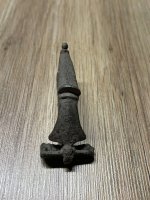KGCnewbieseeker
Sr. Member
The San Juan Mountains of southwestern Colorado contain some of the most rugged country in North America. Superimposed upon this awesome wilderness is a rich zone of mineralization stretching from the La Plata Mountains north to Silverton and Ouray and east to Creede and Summitville. The San Juans have been described as "the best and worst mining country ever struck". These mountains are uniquely enriched in ore deposits but the ruggedness of the area has always impeded exploration and production.
Ouray County is home to some of the most forbidding country in the entire San Juan complex. Located along the northwestern edge of the great San Juan volcanic field, the county is blessed with spectacular mountain scenery. Towering alpine peaks and deep glacial valleys dominate this part of the San Juans.
Ouray County is also home to a number of well-documented lost mines. These include the Lost Owl Creek Mine near Ouray, the Lost Oak Creek Mine on Whitehouse Mountain, and the Lost Colorado Lode near Engineer Mountain. This last mine is located in some of the most treacherous country in the entire San Juans, the headwaters of Bear Creek.
Some of the richest gold ore ever to come out of the San Juans was discovered somewhere in this very same area, near Bear Creek. In 1906, a Swedish miner named Gus Lindstrom stumbled upon this fantastic gold deposit while traveling from Lake City to Ouray. Lindstrom's route from Lake City was up Henson Creek, across the southern edge of American Flats, and then down Bear Creek
Trail to the old toll road near Bear Creek Falls. While hiking down the Bear Creek Trail, west of American Flats, Lindstrom was caught in a blizzard which forced him to seek cover. He eventually found a "cleft in a ledge of rock" where he was able to take shelter from the storm.
Calaverite AuTe2
It was at this time that he made his discovery. There, at his feet, was a 12-inch vein of pure calaverite! Lindstrom filled his gunny sack with ore while he waited for the storm to abate. Later that day, although it was still snowing, Lindstrom was able to resume his journey down to the Bear Creek Trail. The gentle, but steady snowfall was sufficient to slow him down and obscure most of the local landmarks. Nevertheless, Lindstrom was able to strike the Bear Creek Trail before nightfall.
Lindstrom's calaverite ore was analyzed at the assay office in Ouray. When the assay came back, Lindstrom was astounded by its richness. The incredibly rich ore assayed out at over $200,000 per ton! Unfortunately, Gus Lindstrom was never able to find his way back to the notch in the mountainside containing his calaverite vein. In 1909, Lindstrom was committed to the State Hospital in Pueblo.
J.T. Boyd, one-time superintendent of the Camp Bird Mine, was one of the few people who actually saw Lindstrom's ore during the fall of 1906. Although he never found Lindstrom's vein, he did find several pieces of calaverite "float" along Bear Creek. In 1917, a prospector named Phil Dunbar found the same kind of float near the headwaters of Bear Creek. No one has ever been able to locate the vein itself. One of the richest lode deposits in mining history still lies hidden somewhere in the upper basin of Bear Creek.
Ouray County is home to some of the most forbidding country in the entire San Juan complex. Located along the northwestern edge of the great San Juan volcanic field, the county is blessed with spectacular mountain scenery. Towering alpine peaks and deep glacial valleys dominate this part of the San Juans.
Ouray County is also home to a number of well-documented lost mines. These include the Lost Owl Creek Mine near Ouray, the Lost Oak Creek Mine on Whitehouse Mountain, and the Lost Colorado Lode near Engineer Mountain. This last mine is located in some of the most treacherous country in the entire San Juans, the headwaters of Bear Creek.
Some of the richest gold ore ever to come out of the San Juans was discovered somewhere in this very same area, near Bear Creek. In 1906, a Swedish miner named Gus Lindstrom stumbled upon this fantastic gold deposit while traveling from Lake City to Ouray. Lindstrom's route from Lake City was up Henson Creek, across the southern edge of American Flats, and then down Bear Creek
Trail to the old toll road near Bear Creek Falls. While hiking down the Bear Creek Trail, west of American Flats, Lindstrom was caught in a blizzard which forced him to seek cover. He eventually found a "cleft in a ledge of rock" where he was able to take shelter from the storm.
Calaverite AuTe2
It was at this time that he made his discovery. There, at his feet, was a 12-inch vein of pure calaverite! Lindstrom filled his gunny sack with ore while he waited for the storm to abate. Later that day, although it was still snowing, Lindstrom was able to resume his journey down to the Bear Creek Trail. The gentle, but steady snowfall was sufficient to slow him down and obscure most of the local landmarks. Nevertheless, Lindstrom was able to strike the Bear Creek Trail before nightfall.
Lindstrom's calaverite ore was analyzed at the assay office in Ouray. When the assay came back, Lindstrom was astounded by its richness. The incredibly rich ore assayed out at over $200,000 per ton! Unfortunately, Gus Lindstrom was never able to find his way back to the notch in the mountainside containing his calaverite vein. In 1909, Lindstrom was committed to the State Hospital in Pueblo.
J.T. Boyd, one-time superintendent of the Camp Bird Mine, was one of the few people who actually saw Lindstrom's ore during the fall of 1906. Although he never found Lindstrom's vein, he did find several pieces of calaverite "float" along Bear Creek. In 1917, a prospector named Phil Dunbar found the same kind of float near the headwaters of Bear Creek. No one has ever been able to locate the vein itself. One of the richest lode deposits in mining history still lies hidden somewhere in the upper basin of Bear Creek.




